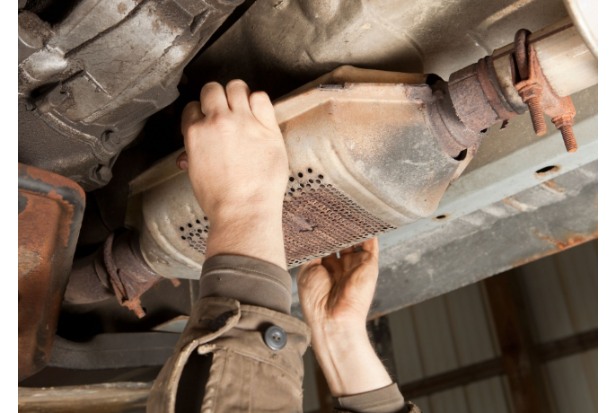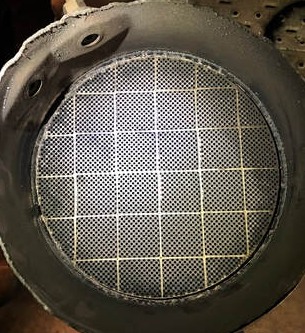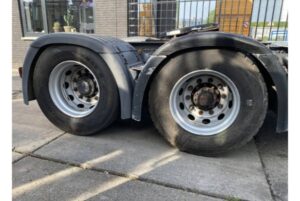
Do Diesel Trucks Have Catalytic Converters – Truck Guide
Do diesel engines possess catalytic converters? In this blog post, we’ll respond to that query and many others regarding diesel catalytic converters.
In recent decades, lowering vehicle emissions has been made possible in large part by the addition of catalytic converters to vehicles. Nevertheless, what about diesel engines? Do diesel vehicles possess catalytic converters? Are there catalytic converters on diesel trucks? Logan drivers frequently ask these questions, and the short answer is that yes, diesel engines do have catalytic converters. Let’s briefly discuss what catalytic converters do and which diesel vehicles have them.
What Does a Catalytic Converter Do?
The majority of Logan drivers have probably heard of catalytic converters, but few are likely to be able to describe what they do in detail. In essence, they use precious metals to inject oxygen into an engine’s exhaust, turning the dangerous Carbon Monoxide fumes into diatomic nitrogen and water. As a result, a vehicle’s harmful emissions are greatly decreased.
Do Diesels Have Catalytic Converters?
What about diesel engines? Do diesel vehicles possess catalytic converters? Catalytic converters are present in almost all diesel engines made after 1990. Most cars made before that period do not. Around that time, it became clear that this technology was essential for diesel engines in particular to reduce emissions.
How Does the Diesel Catalytic Converter Work?
By transforming toxic substances into non-toxic ones, the diesel catalytic converter is in charge of reducing emissions. Two ceramic blocks with thousands of tiny cells each, resembling a honeycomb, are housed inside the metal casing.
A metal coating, such as platinum or palladium, is present on every ceramic block. In order to catalyze the chemical reactions, the catalytic converter heats up and is placed closer to the engine. Through these processes, harmful gases are changed into byproducts that can be released into the atmosphere.
The way a gas engine works is very similar to how the Diesel Oxidation Catalyst (DOC) works. Metal catalysts are used to convert carbon monoxide into water and carbon. The emissions of hazardous gases are decreased during this period as the volatile hydrocarbons and byproducts are converted into less hazardous substances. This cat, unlike the gas engine, does not, however, contain rhodium. The diesel particulate filter (DPF), which removes particles not found in the gas-centered converter, is also a part of it.
Nitrogen Oxide (NOx) is converted into Nitrogen and Oxygen by the SCR with the aid of an ammonia-based catalyst. A reduction in NOx emissions of between 75% and 90% is possible with this open-loop system. SCR is also required to lower hydrocarbon emissions, but it is only about 8% effective. Performance is enhanced by the use of low sulfur fuel.
Do Diesel Engines Have Catalytic Converters?
Yes, a lot of diesel vehicles come equipped with catalytic converters, but not in the same way that a gas-powered vehicle does. Some diesel engines have two-way catalytic converters with diesel oxidation catalysts; however, it may also have a three-way design with an SCR reduction.
EGR (Exhaust Gas Recirculation), DPF (Diesel Particulate Filtration), DOC (Diesel Oxidization Catalyst), and SCR (Selective Catalytic Reduction) are the four stages that diesel engine emissions go through. When the catalysts are producing chemical reactions to lower emissions, that is known as the DOC and SCR stages.
Check Out the Diesel Trucks at Your Nearest Truck Ranch
We always have a large selection of modern, high-quality diesel trucks available. Why not visit us and try out one or more of them? Additionally, if you want to learn more about diesel engines, see our comparison of diesel and gas trucks and our checklist for maintaining diesel engines. We’re eager to assist you in getting behind the wheel of your next truck because we want to see you do it.
How Long Does a Diesel Catalytic Converter Last?
The diesel catalytic converter has a potential lifespan of 100,000 miles, or roughly ten years. However, the length of your trips and how you treat the car will determine how well it will perform. The catalytic converter may wear out too soon if you frequently take shorter trips.
Shorter trips cause the engine to shut off before the converter reaches the proper operating temperature to catalyze the compounds. The converter experiences more wear as a result of this occurring more frequently.
Signs of a Failed Diesel Catalytic Converter
If you are aware of the warning signs that the converter is failing, you can quickly have it replaced. The converter may fail too soon for some reason. A few of the most common causes for premature failure include:
- Free flow of exhaust gases is restricted
- Build-up of carbon deposits
- Physical damage
- Overheating
- Poor engine maintenance
In order to determine whether a catalytic converter is necessary, the majority of modern cars use oxygen sensors. The Check Engine Light illuminates when the oxygen sensors don’t receive the correct reading. To identify the problem’s root cause, use a code scanner.
Aside from the Check Engine Light, you might also notice these symptoms that the catalytic converter is failing:
- Poor engine performance
- Trouble accelerating
- Rotten egg smell from the exhaust
- Dark exhaust smoke
Diesel Catalytic Converter Replacement Cost
It won’t be cheap to replace the catalytic converter. It costs the same as a gas-powered car, if not more. Depending on your vehicle and the converter’s material, you can anticipate spending anywhere between $900 and $2,500 on average. Parts and labor are both included in this estimate.
You might make a small financial savings if you can replace the item yourself. However, the part itself accounts for the bulk of the costs.
mainly because a new catalytic converter is quite expensive. To keep their vehicles from being stolen, some drivers decide to add theft-proof features. You can easily keep the catalytic converter secured against thieves for less than $50.

Can the Car Run Without a Diesel Catalytic Converter?
There is nothing preventing the car from moving even without its catalytic converter. You won’t be left stranded without the engine because it will continue to run. The emissions regulations won’t be the same, though, and you might experience some issues with engine performance.
Catalytic converters are additionally mandated by law. You risk receiving hefty fines if you drive your car without one. The issue is not that you are responsible for getting an emissions test; rather, it may be discovered during the safety inspection when you go to renew your registration.
Does Catalytic Converter Cleaning Work?
The catalytic converter may clog as carbon accumulates inside of it. There are other options besides replacing the catalytic converter, contrary to what some people believe. Catalytic converter cleaning products are available.
The effectiveness of these catalytic cleaner products is a hotly debated topic, but the majority of people believe it is worthwhile to give them a shot. You might avoid having to install a new converter by spending a small sum on a straightforward cleaner.
Furthermore, some people discover that using a catalytic converter cleaner can prolong the life of this priceless component. A bottle should be used every 3,000 to 4,000 miles, as advised by many products, but this recommendation is excessive. If you use it twice per year while traveling the typical number of miles, you ought to be able to see results.
Common Problems of Diesel Engine Catalytic Converters
Diesel engine converters have issues, just like any other catalytic converter. They are prone to a few difficulties that you would need to consciously avoid happening or address once they do. Some of the common problems of diesel engine catalytic converters are:
Contamination
The catalytic converter may be exposed to engine coolant escaping from a malfunctioning cylinder head’s designated location. This may automatically affect how easily exhaust gases pass through the converter.
Carbon Deposits Blockage
Carbon buildup in the catalytic converter over time has a tendency to clog the system. When the converter is blocked, it cannot carry out its intended function.
Restriction of Exhaust Gas Free Flow
A vehicle’s engine needs a steady flow of air to operate effectively. When the exhaust system’s free flow of gas is restricted, the supply of air is inevitably impacted as well, which ultimately has a negative impact on the engine. With the cat converter, this is a typical problem.
Overheating
A leaky exhaust valve and defective glow plugs are two causes of insufficient diesel fuel combustion. When this happens, overheating is imminent because the unburned fuel might be directed to the converter so that it can burn properly. The converter’s operation will undoubtedly be hampered by this.
Physical Damage
A vehicle’s catalytic converter is mounted from below, in line with the engine and the exhaust system. Unfortunately, this exposes the component to mechanical processes that may cause wear, tear, or damage over time.
The component is also susceptible to the elements of the weather and the road, which can quickly damage the component when they come into contact with it. Another harmful element is the vibration from traveling on unpaved roads.
How Do You Fix Diesel Engine Catalytic Converters Problems?
If you’re able to pinpoint the root of the issue, fixing a diesel engine cat converter issue will be simple. It would therefore be best to carefully identify the precise problem by inspecting or diagnosing the component. A damaged diesel engine catalytic converter can be fixed, though, by following the suggestions below.
Unclog the Converter
First, if carbon buildup is the cause of the catalytic converter problem, make sure to unclog it with a degreaser and hot water solution. When the solution is prepared, soak the converter in it for approximately an hour.
Grab a pressure washer after that and turn it to low. After carefully rinsing the component with water, let it dry properly by letting the water drain out of it. Reinstall the component following that. Remember that a diesel catalytic converter cleaner can be used to complete the task as well.
Replace Faulty Related Parts
If the oxygen sensor, head gasket, etc., is responsible for the malfunctions that led to the problem with the catalytic converter, ensure to replace the exact component. Before making a replacement, carefully diagnose the issue to pinpoint the precise faulty component.
Replace the Catalytic Converter
If all other efforts have failed and the catalytic converter is still dysfunctional, you should finally consider replacing the part. Catalytic converter replacement can be pricey, but it’s better to deal with a problem now rather than waiting for it to get worse.
Can a Diesel Engines Run Without a Catalytic Converter?
Of course, a diesel engine can function without a catalytic converter because the device is not necessary for a vehicle’s locomotion. The performance of the car’s engine will be altered overall if the converter is not present, and driving without it will make the engine make unpleasant noises.
In addition to the consequences of having a catalytic converter missing from a vehicle, the vehicle will probably fail the emissions test if the component is absent. It is prohibited to operate a vehicle without a cat converter, and the emissions from the exhaust pipes of such a vehicle endanger the environment.
In order to ensure that every vehicle produced after 1975 is equipped with at least one catalytic converter, it is the responsibility of the Environmental Protection Agency. This strictly complies with the Clean Air Act of 1970.
Don’t risk removing the catalytic converter from your car if your diesel engine can still function without it. By doing this, you run the risk of receiving a fine or failing your subsequent emissions test.
When the component is perfectly fine on your car, what’s the point of removing it? The element not only gives you an advantage in passing an emissions test, but it also shields you and everyone else from harmful exhaust pollutants.
If you were wondering, “Do contemporary diesel vehicles have catalytic converters?” Remember, the 1970 Clean Air Act applies to all vehicles manufactured after 1975, so of course they do.
FAQs
Do Diesel Catalytic Converters Get Stolen?
Of course, just like those used in automobiles powered by gasoline, diesel catalytic converters are also stolen. The causes of the hassle are essentially the same in both situations because diesel and gasoline engines’ catalytic converters can be used to make a few dollars.
Therefore, it is clear that converter vandals have no business attempting to distinguish between vehicles with gasoline engines and those with diesel engines. If you’re wondering, “Do thieves steal diesel engine cat converters?” they are all potential victims. Consequently, you must jealously guard your car.
Are Diesel Engine Catalytic Converters Worth Anything?
In the market for scrap metal, diesel catalytic converters are worth a pretty penny. They cost less than catalytic converters for gasoline engines, though. Diesel fuel is cleaner than regular gasoline, so the converter only needs a small amount of catalysts.
To put it another way, the precious metals used in the catalytic converters for gasoline engines are higher than those used in the equivalent units for diesel engines. In any case, when sold as scrap, the diesel catalytic converters still bring in a profit.
How Much is a Diesel Catalytic Converter Worth?
Anywhere between $18 and $625 is the value of a scrap diesel catalytic converter. The make and model of the vehicle affects the converter’s price, though. Catalytic converters for diesel engines can range in price from this to a little bit more.
Anyhow, an old converter still has some financial worth. To make a few dollars, you could sell it to a local junkyard or scrap metal buyer.
What Year Did Diesel Start Using Catalytic Converters?
When were catalytic converters first installed in diesel engines? Around the 1990s, catalytic converters for diesel engines were introduced. Due to the quantity of pollutants released through gasoline-powered vehicles’ exhaust pipes up until that point, the parts were frequently found in gas engines.
Typically, the mid-1970s saw the widespread adoption of catalytic converters as a result of the decline in air quality in many cities around the 1940s and 1950s. This ended up being the remedy for the air pollution issue.
What Cars Don’t Have Catalytic Converters?
The only automobiles without catalytic converters are all-electric vehicles. Instead, they feature rechargeable batteries that provide the EVs’ power without creating any emissions. Catalytic converters are installed in various other vehicles, such as hybrids, gasoline-only cars, and diesel-powered vehicles.
The explanation is fairly straightforward: the emissions from these cars have a detrimental effect on the atmosphere’s air quality. As a result, the converters aid in detoxifying the pollutants before the exhaust pipes release the emissions.
Do Thieves Target Diesel Catalytic Converters?
Of course, diesel catalytic converters are also targeted by cat converter thieves; if you’re asking, “Are diesel catalytic converters stolen by criminals?” This is due to the fact that some precious metals are present in their structure. Therefore, whether you drive a diesel or gasoline-powered vehicle, be sure to keep your converter away from people who won’t miss an opportunity to steal it.
Theft of catalytic converters is still on the rise. The National Insurance Crime Bureau (NICB) reported that 3,389 converter theft claims were filed by vehicle owners in 2019 and a staggering 14,433 claims were filed in 2020.
Where is the Catalytic Converter on a Diesel Truck?
The catalytic converter on a diesel truck is located underneath the car, between the muffler and the engine. As a part of the exhaust system, the component is installed. Catalytic converters are typically located in the same region on vehicles.
However, depending on the make and model of the car, some are built with just one catalytic converter while others have two or more. Unfortunately, you have to be more vigilant about theft the more converters there are.
How Much is a Cummins Catalytic Converter Worth?
A Dodge Cummins 6.7 catalytic converter is worth $60 to $600. Protect the converters in your Ram 2500, RAM 3500, 4500, 3500 heavy-duty truck, or 5500 Chassis Cab from thieves.
When a new cat converter is installed, you can sell the old one to generate some extra cash. However, make sure to check the price of a scrap catalytic converter online before getting in touch with a junkyard or scrap metal dealer in your area.
Do Ford Diesel Have a Catalytic Converter?
Yes, catalytic converters are built into Ford vehicles with diesel engines. As of today, diesel engines produced in the 1990s and earlier contain the component. The converters are typically necessary for removing the toxic pollutants from the exhaust systems of the vehicles.
The part in charge of properly managing the emissions system and preventing the release of toxins is the cat converter if you drive a Ford F-150 with a Power Stroke diesel engine. Driving the F-150 would have been against the law in the US without the component.
Do Heavy-duty Trucks Have Catalytic Converters?
Of course, catalytic converters are a standard feature of heavy-duty vehicles. To reduce the problems caused by hazardous emissions, the element is required. With the exception of electric cars, almost all vehicles require a cat converter.
Since heavy-duty trucks’ cat converters are made of some precious metals, like those in most cars, converter vandals also target them. Some trucks, however, have a cat-con that is relatively less expensive and does not attract the attention of experts in converter theft.
Final Words
The availability of catalytic converters in diesel engines was accurately disclosed in this article. Additionally, a few of the component’s typical issues have been discussed, along with suggested fixes.



Average Rating